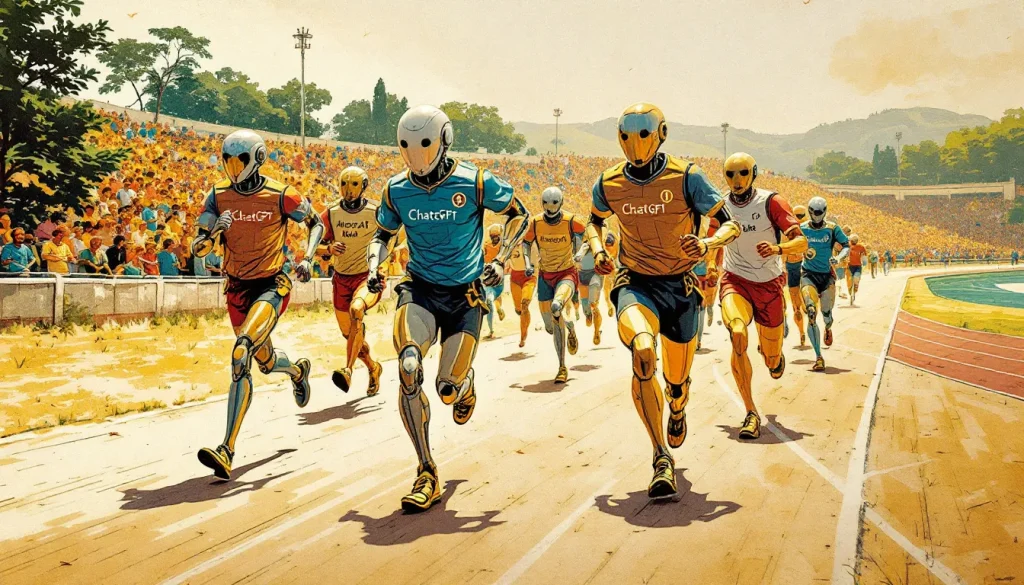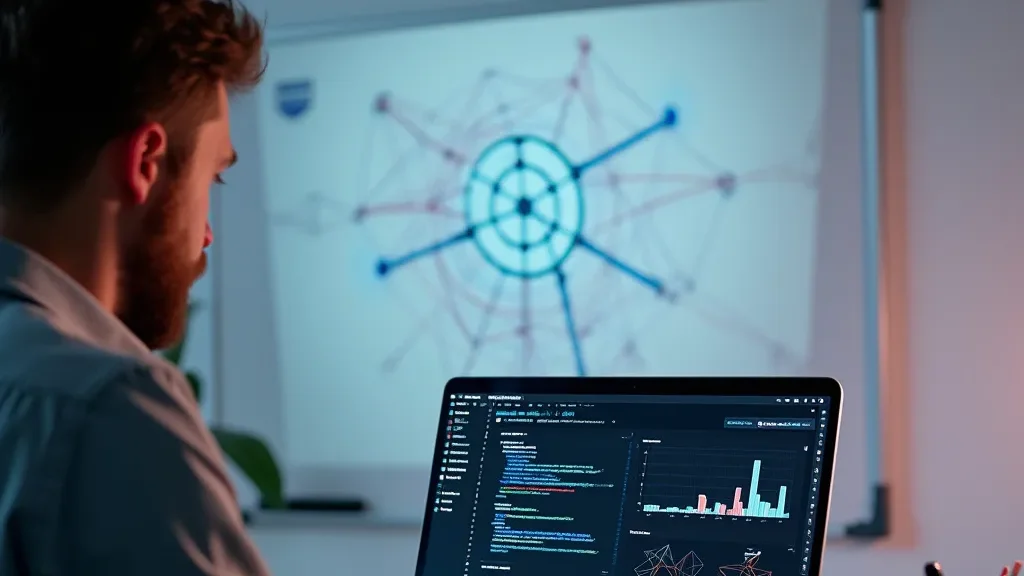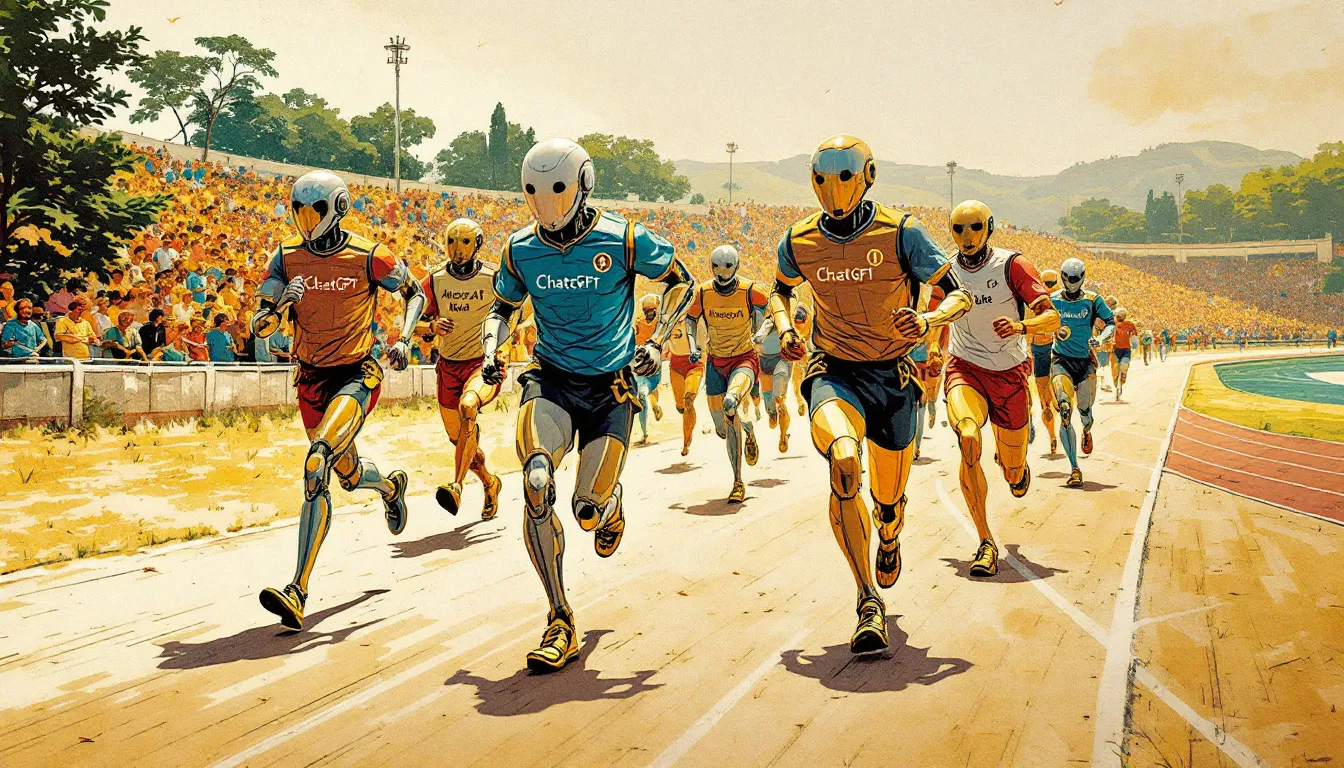Spoiler: ChatGPT is the best because it is the one we train the most among all of us
This month, OpenAI unveiled a new artificial intelligence (AI) model, called O1 , which marks an important advance in the ability to "reason". Unlike previous versions, this model can break down complex problems into simpler steps and solve them more efficiently. This has big implications for tasks like programming, science, and advanced math.
The interesting thing about o1 is that it improves without the need to make the models larger or more expensive. This approach makes AI more accessible to companies that don't have the resources of giants like Google or Amazon. However, while OpenAI is clearly leading with these advancements, it's not the only company in the game. Google, with its own AI division, is also developing similar technologies.
What does this mean for businesses?
- Smarter, more efficient solutions : If your company is looking for solutions to improve decision-making or automate complex processes, OpenAI offers significant advances with o1.
- Is ChatGPT the best AI? : It depends on what your company needs. OpenAI leads in generative AI (creating texts, images, etc.), but other competitors are also making strides in key areas such as decision-making and data analytics. The important thing is to evaluate which AI best solves your specific problem.
- Access to innovation without large investments : With this new model, OpenAI proves that you don't need to have the resources of a tech giant to leverage AI. Even smaller companies could benefit from these advances in artificial intelligence.
To give a clear and complete answer, let's first look at the evolution of OpenAI and ChatGPT, then their competitors, and finally how the number of users impacts their learning.
Evolution of OpenAI and ChatGPT
OpenAI was founded in 2015 by Elon Musk, Sam Altman, Greg Brockman, and others. Its initial mission was to develop artificial general intelligence ( AGI ) that benefits all humanity. Since then, she has made significant strides with her model family GPT (Generative Pretrained Transformers ).
- GPT-1 (2018) : An early language model that already stood out for its ability to generate coherent text, although limited compared to current models.
- GPT-2 (2019) : This model caught the attention because it was much more powerful, generating text convincingly and answering complex questions. OpenAI decided not to release the full version initially for fear of misuse.
- GPT-3 (2020) : With 175 billion parameters, GPT-3 revolutionized generative AI, enabling not only text generation, but the creation of applications for tasks such as scheduling, writing, customer service, and more.
- ChatGPT (2022) : Built on GPT-3.5 and then GPT-4, ChatGPT marked a milestone by allowing anyone to access powerful conversational AI. This tool accumulated more than 100 million users in a few months and continues to be one of the most used AIs in the world.
Competitors : Companies such as Google DeepMind , Anthropic and Cohere They have developed their own versions of language models. Google, with Bard (based on your model Palm ), has been competing directly with OpenAI, while Anthropic , founded by former OpenAI members, has developed Claude , another conversational AI system.

Impact of the number of users on learning
ChatGPT It has been especially successful thanks to its large number of users, and this volume of interactions plays a crucial role in its continuous improvement.
Number of users :
- ChatGPT (OpenAI): More Than 180 million active users (data from mid-2024), making it the market leader in terms of users.
- Bard (Google): Launched in 2023, it has a smaller user base, although Google hasn't shared exact figures. Estimates place Bard around the 30-40 million users .
- Claude (Anthropic): Although it is a relevant competitor, it has an even smaller user base, estimated at 5-10 million .
Relationship between use and learning :
AI models like ChatGPT are based on Supervised Learning and Reinforcement learning . Each interaction with users provides data that helps fine-tune the model. The more users interact with AI, the more feedback receives to adjust their answers. This allows the model to:
- Improve your accuracy in text generation.
- Fix Errors in real time through reinforcement learning.
- Expand your knowledge on new areas by being exposed to a variety of questions and situations.
For example, OpenAI's o1 model, mentioned in your original idea, is a clear example of how OpenAI is using massive interactions to improve the reasoning ability of its models.
A comparison based on the number of users and the approaches of each AI:
| AI Model | Enterprise | Active users (approx.) | Predominant use | Learning Level |
|---|---|---|---|---|
| ChatGPT (GPT-4) | OpenAI | 180 million | Conversation, text generation, programming. Used in companies for customer service and automation. | The most trained, continuously improves thanks to the large user base. |
| Bard | Google DeepMind | 30-40 million | Advanced search, content creation, Google Workspace integration. | Less trained, but strong at specific tasks because of Google data. |
| Claude | Anthropic | 5-10 million | Conversational interactions and data analytics, increased focus on AI safety and ethics. | Focused on ethics and security, less user data. |
| Mistral AI | Cohere | N/A | Focused on text analysis and specific tasks for companies. | Developing, but with less user interaction. |
OpenAI with ChatGPT it remains the clear leader not only in terms of the number of users, but also in how these users help improve AI. Every time someone uses ChatGPT, the model has the opportunity to learn and improve. Meanwhile, competitors such as Google DeepMind with Bard and Anthropic with Claude are also making significant strides, but they are still far behind in terms of users and therefore in their ability to learn based on mass interaction. For a company looking to integrate AI, The best option It depends on the type of tasks they need to solve and how much they value a model that keeps continuously improving with use.

What is AGI?
The Artificial General Intelligence (AGI) refers to an AI capable of performing any human cognitive task with the same level of intelligence and adaptability. In other words, an AGI could learn, reason, and apply knowledge in the same way as humans, without needing to be trained for specific tasks. This is very different from current AIs, which are models limited to specific tasks (such as text generation or image recognition), although they are increasingly advanced.
The concept of AGI dates back to the beginnings of computing and AI, in the 1950s and 1960s, when pioneers such as Alan Turing and John McCarthy they began to imagine machines that could "think." Unlike narrow or specific artificial intelligence ( narrow AI ), which only solves concrete problems, AGI aspires to a full-fledged human intelligence, with the ability to adapt to any problem or task, learning autonomously and continuously.
Why is AGI important?
Achieving AGI would imply a monumental change for humanity. Some of its implications are:
- Automation total : Not only manual or repetitive tasks would be automated, but also creative, strategic, and decision-making processes in almost every industry.
- Accelerated progress : AGI could solve complex scientific problems at speeds unthinkable to humans, from finding cures for diseases to designing advanced technologies.
- Ethical and control risks : Since an AGI would be extremely powerful, there would be great debates about how to regulate it, control it, and ensure that it is used for the common good. There is a risk that, if not managed well, it could amplify inequalities or even pose an existential danger if its decision-making is not aligned with human interests.
How far are we from Artificial General Intelligence?
No company has reached AGI yet, and it is estimated that they could pass Decades before it is achieved, if it is achieved at all. However, some companies are closer than others, based on their recent advancements and technology strategies. Here's an idea of how close or far OpenAI, Google DeepMind, and other competitors are in the race to AGI:
OpenAI :
- Recent developments : OpenAI has pioneered models such as GPT-4 and the recent o1, which have improved the reasoning ability of AIs. With each iteration, your models get closer to a type of intelligence that you can generalize to various tasks, which is one of the key requirements for AGI.
- Projection towards AGI : OpenAI is among the leaders in the race to AGI. Their focus on using reinforcement learning and chained reasoning in models such as o1 suggests that they seek to develop cognitive abilities closer to human intelligence. However, it is still far from a system that can fully match the flexibility and adaptability of a human being.
- Estimate : Far , but at the forefront.
Google DeepMind :
- Recent developments : Google DeepMind has developed AI that can outperform humans in complex games like chess and Go, and more recently has made major strides in areas like geometry and biology. Models such as AlphaGo and AlphaFold have shown that DeepMind is a key player in tasks that require advanced reasoning and specialized knowledge.
- Projection towards AGI : DeepMind is also exploring the combination of symbolic AI and language models to improve reasoning. Its CEO, Demis Hassabis , has mentioned that the use of Reinforcement learning is key to moving towards AGI. DeepMind has access to massive data resources and infrastructure from Google, which gives it an edge.
- Estimate :Also far , but their focus on specific problems of high scientific impact positions them well in the race.
Anthropic :
- Recent developments : Anthropic has developed Claude, a language model with a special focus on AI safety and ethics. Although less advanced in terms of number of users and overall capabilities compared to OpenAI and Google, Anthropic is focused on building reliable and secure AIs, a crucial factor for an eventual AGI.
- Projection towards AGI : Their emphasis on security indicates that they want AI that is more controlled and aligned with human values before accelerating towards general intelligence. They are further away in terms of technical capabilities, but they do not neglect risks, which can be valuable in the long run.
- Estimate : Late in current capacities, but moving with caution towards a safe AGI.
Other competitors (Cohere, Mistral, etc.) :
- Recent developments : Smaller companies such as Cohere and Mistral they are focused on more specialized areas of AI, such as language model optimization and text analysis for business tasks. These players are far from developing an AGI, as they are focused on solving specific, practical problems.
- Projection towards AGI :Are far away compared to OpenAI and DeepMind, as they have neither the infrastructure nor the scale of users needed to approach AGI anytime soon.
Comparison in the race to AGI
| Enterprise | Moving towards AGI | Main achievements | Estimation of Proximity to AGI |
|---|---|---|---|
| OpenAI | Models such as o1 show improvements in complex reasoning. | GPT-4, ChatGPT, o1. | He leads the race, but still far away. |
| Google DeepMind | Strong focus on reasoning through symbolic AI and reinforcement learning. | AlphaGo, AlphaFold, Bard. | Very close to OpenAI, but still lacking. |
| Anthropic | They prioritize safe AI aligned with human values. | Claude. | Behind in technical capacities. |
| Cohere/Mistral | Less focus on AGI, more on specialized enterprise AI. | Optimization of language models. | Far from AGI. |
In terms of AGI, companies like thanks to their advances in AI models that can increasingly perform more complex and diverse tasks. However, there is still a long way to go to reach true AGI. Current models are still limited to specific tasks, and while the number of users improves their ability to learn and adapt, they still don't have the versatility and understanding of the world that humans possess.
The path to AGI requires not only technological advances, but also a deep reflection on risks, safety, and social impact.
